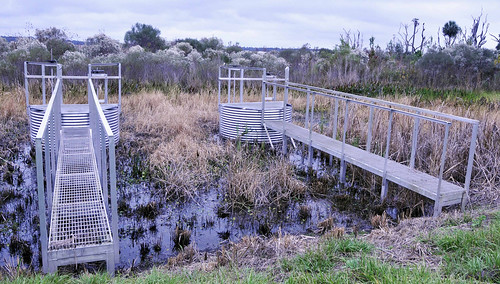
Kelly McPherson walks the Spanish moss draped trail, where hikers view a variety of wildlife throughout the year. NRCS photo.
About 20 minutes south of downtown Gainesville, Fla. lies 1,060 acres of fresh water marsh, home to bobcat, wood duck, muskrat, bald eagle, sandhill crane and other wildlife species. This public land features six and a half miles of trails, which weave through Florida’s unique wetland landscape.
But the Levy Prairie wetland basin hasn’t always been a recreation getaway.
In the late 1960s, ranchers built levees around the area, dug canals and continually kept it drained for pastures to raise cattle. Then in 2001, one of the ranchers in the area decided to return the land to its natural state with the help of USDA’s Natural Resources Conservation Service (NRCS).
The landowner enrolled the land into a conservation easement through the former Wetlands Reserve Program, which provides financial assistance for farmers, ranchers and forest landowners who transform working lands into wetlands. The 2014 Farm Bill merged this program with two other easement programs, forming the Agricultural Conservation Easements Program.
NRCS specialists oversaw the restoration, repairing the levees and installing water control structures to give managers the ability to change the water levels and lessen downstream flooding. Re-flooding the marsh allowed native plants to get a foothold and return the system to an herbaceous marsh.
After the restoration was underway, Alachua County purchased the property for public use in 2009 as part of a land conservation program called Alachua County Forever. Kelly McPherson, Alachua County Environmental Protection Department land manager, works with NRCS to continue restoration and manage the property.
“Levy Prairie is a mosaic of diverse native vegetation,” she said. McPherson visits the marsh weekly to monitor the water levels, vegetation and wildlife habitat.
McPherson can describe how each season brings distinctive colors and unique wildlife to the wetland. In spring pink sprays of Decodon verticillatus dot green grass fields, in summer light green habenaria orchids open, and in fall cadmium yellow bur marigolds can be seen next to deep purple asters.
Birdwatchers head to the marsh to see sandhill cranes nesting in late winter and early spring. Bald eagles can be viewed between May and October. Members of the Alachua Audubon have caught sight and sound of willow flycatchers, an endangered species.
Recently, the county added a new kiosk on site that explains the ecological highlights of the marsh and painted bike stands sculpted into metal snakes teach visitors the differences between poisonous water moccasins and their look-alike harmless Florida water snakes.
The work isn’t done. Another leg of trail, perhaps a boardwalk is planned for a future phase. And, of course, wetlands evolve over the years and this one is already more than a decade in the making. But there is plenty of time, as the conservation easement protects the Levy Prairie easement forever.
To get started with NRCS, visit your local USDA Service Center or www.nrcs.usda.gov/GetStarted.

NRCS installed water control structures that lessen downstream flooding. NRCS photo.
No comments:
Post a Comment
Note: Only a member of this blog may post a comment.